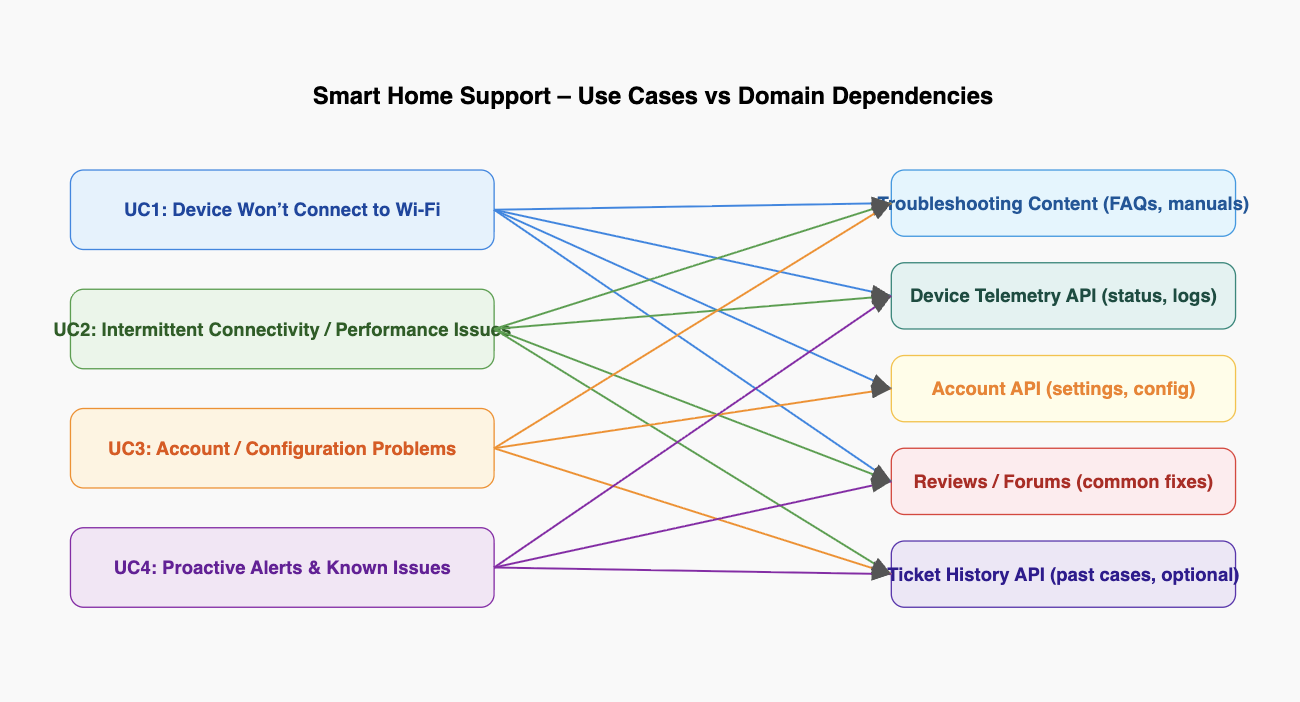Multi-Domain Orchestration for Customer Support Augmentation
Consumer technology has grown more connected, more personalized, and more complex. As a result, customer support interactions increasingly involve troubleshooting smart devices that rely on network connectivity, cloud services, user accounts, and firmware. When a customer says, “My smart home device won’t connect to Wi-Fi. What should I try?”, they are really asking for an integrated diagnostic and guidance experience—one that synthesizes information across multiple domains.
Multi-domain orchestration enables support assistants to deliver that experience. By unifying real-time device telemetry, account configuration data, troubleshooting knowledge bases, and community-derived insights, support systems can guide users more quickly and reliably than traditional scripted flows.
Understanding the Use Case
A user experiencing Wi-Fi connectivity issues expects more than generic advice. They want help that accounts for:
the device’s recent online status
their specific network configuration
known issues with their model or firmware
steps that worked for other customers
official troubleshooting guidance
This requires information from several specialized domains, each providing a unique piece of the problem-solving puzzle.
Required Domains and Their Roles
1. Troubleshooting Content
Includes structured and curated support resources such as:
FAQs
step-by-step troubleshooting guides
device manuals
official support articles
quick-start or reset instructions
Role in orchestration:
Provides authoritative, vendor-approved solutions and ordered decision trees for resolving common problems.
2. Device Telemetry API
Offers real-time or recent diagnostic signals from the user’s device:
last online timestamp
Wi-Fi strength or disconnection logs
firmware version
error codes
environmental factors (e.g., temperature, signal quality)
Role in orchestration:
Allows the system to tailor troubleshooting instructions based on what the device is actually experiencing—reducing guesswork and unnecessary steps.
3. Account API
Contains personalized user context:
network configuration (SSID, setup history)
paired devices
custom settings
regional settings or restrictions
subscription or feature availability
Role in orchestration:
Aligns troubleshooting with the user’s actual setup. For example, if the account shows the device is assigned to a disabled network profile, that insight drives a more accurate recommendation.
4. Reviews and Community Forums
Aggregates informal but highly valuable user insights:
common complaints
workaround steps
emerging issues after recent firmware updates
crowd-validated solutions
Role in orchestration:
Surfaces patterns that haven’t yet made it into official documentation. Community-sourced knowledge helps fill the gap between product release cycles and support updates.
Why Multi-Domain Orchestration Is Essential
Customer support queries about smart devices live at the intersection of hardware, software, network environments, user behavior, and documentation quality. No single domain captures the full picture.
For example, a device may fail to connect because:
The Wi-Fi password changed (account settings).
The device last connected 10 minutes ago but dropped due to weak signal (telemetry).
A known bug affects the latest firmware (community insights).
The user skipped a step in initial setup (troubleshooting content).
Only through orchestration can the system identify and prioritize likely causes, offering personalized steps instead of generic advice.
How Orchestration Creates Value
1. Personalized, Context-Aware Troubleshooting
By blending telemetry and account data with existing knowledge bases, the assistant can deliver tailored guidance such as:
“Your device last reported a weak Wi-Fi signal—try moving it closer to the router.”
“Your network name changed yesterday. Re-run setup to update your device’s Wi-Fi credentials.”
This improves accuracy and reduces time-to-resolution.
2. Faster Problem Identification
Orchestration allows the support assistant to automatically check:
device logs
recent error codes
known issues in the community forums
coverage in official documentation
This produces a more precise diagnosis without requiring the user to describe technical details.
3. Proactive Recommendations
By integrating community insights, the system can say:
“Many users reported reconnecting successfully after restarting their router with this firmware version.”
This brings the benefits of collective experience into official support flows.
4. Reduced Escalations and Higher Satisfaction
Support agents and automated assistants alike benefit from:
fewer repetitive troubleshooting cycles
more complete information at the start of the conversation
higher first-contact resolution
This leads to faster outcomes and better user experiences.
Conclusion
Modern smart home support requires weaving together structured troubleshooting guides, real-time telemetry signals, account configuration data, and community-driven insights. Multi-domain orchestration empowers support assistants to deliver clear, contextual, and effective help—turning potentially frustrating experiences into fast, guided resolutions.
By merging authoritative documentation with real device data and community wisdom, orchestration forms the foundation of next-generation customer support augmentation.

